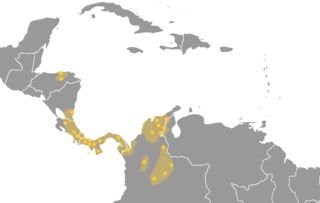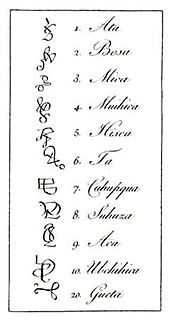
The Muisca are an indigenous people and culture of the Altiplano Cundiboyacense, Colombia, that formed the Muisca Confederation before the Spanish conquest. The people spoke Muysccubun, a language of the Chibchan language family, also called Muysca and Mosca. They were encountered by conquistadors dispatched by the Spanish Empire in 1537 at the time of the conquest. Subgroupings of the Muisca were mostly identified by their allegiances to three great rulers: the hoa, centered in Hunza, ruling a territory roughly covering modern southern and northeastern Boyacá and southern Santander; the psihipqua, centered in Muyquytá and encompassing most of modern Cundinamarca, the western Llanos; and the iraca, religious ruler of Suamox and modern northeastern Boyacá and southwestern Santander.

Chibcha, Mosca, Muisca, Muysca (*/ˈmɨska/), or Muysca de Bogotá, was a language spoken by the Muisca people of the Muisca Confederation, one of the many indigenous cultures of the Americas. The Muisca inhabited the Altiplano Cundiboyacense of what today is the country of Colombia.

Lake Tota is the largest lake in Colombia, located in the east of Boyacá department, inside the Sugamuxi Province, it is the source of the Upia River which flows into the Orinoco River basin.

Lake Guatavita is located in the Cordillera Oriental of the Colombian Andes in the municipality of Sesquilé in the Almeidas Province, Cundinamarca department of Colombia, 57 km (35 mi) northeast of Bogotá, the capital of Colombia.

The Guane were a South American people that lived mainly in the area of Santander and north of Boyacá, both departments of present-day central-Colombia. They were farmers cultivating cotton, pineapple and other crops, and skilled artisans working in cotton textiles. The Guane lived north of the Chicamocha River, around the Chicamocha Canyon in an area stretching from Vélez in the south to the capital of Santander; Bucaramanga in the north. Other sources state their territory did not extend so far north. Guane, a corregimiento of Barichara, Santander, is said to have been the capital of the Guane people.

Spanish conquest of the Chibchan Nations refers to the conquest by the Spanish monarchy of the Chibcha language-speaking nations, mainly the Muisca and Tairona that inhabited present-day Colombia, beginning the Spanish colonization of the Americas.

The goddess Bachué, is a mother goddess that according to the Muisca religion is the mother of humanity. She emerged of the waters in the Iguaque Lake with a baby in her arms, who grew to become her husband and populated the Earth. She received worshipping in a temple, in the area now within the municipality of Chíquiza, formerly called "San Pedro de Iguaque".

Duit is an extinct Chibcha language, which had been spoken by the Muisca of present-day Boyacá, Colombia. The language appears in the modern name of the pre-Columbian settlement and last ruler Tundama; Duitama.
Guecha Warriors were warriors of the Muisca Confederation in the Tenza Valley, Ubaque valley and Altiplano Cundiboyacense in the pre-Colombian era. The Guecha warrior was chosen for his merit in attitude and physique rather than by class. He was recognised by his unique status in society and his adornment with gold, feathers and inks.

Cuchuco is a soup, part of Native American cuisine of South America associated with the Muisca people, made with corn, barley or wheat and mashed beans, popular in Colombian cuisine, especially Altiplano of the Boyacá and Cundinamarca Departments of Colombia. It is a staple food in Colombia, where it is often made with peas, potatoes, wheat and beans.
Muisca people are indigenous people in Colombia.
Thomagata or Fomagata was a mythical cacique who was said to have been zaque of Hunza, present-day Tunja, Colombia, then part of the Muisca Confederation. He is remembered as one of the most religious in the history of the zaques, after Idacansás.

The Muisca calendar was a lunisolar calendar used by the Muisca. The calendar was composed of a complex combination of months and three types of years were used; rural years, holy years, and common years. Each month consisted of thirty days and the common year of twenty months, as twenty was the 'perfect' number of the Muisca, representing the total of extremeties; fingers and toes. The rural year usually contained twelve months, but one leap month was added. This month represented a month of rest. The holy year completed the full cycle with 37 months.

Muisca numerals were the numeric notation system used by the Muisca, one of the civilizations of the Americas before the Spanish conquest of the Muisca. Just like the Mayas, the Muisca had a vigesimal numerical system, based on multiples of twenty. The Muisca numerals were based on counting with fingers and toes. They had specific numbers from one to ten, yet for the numbers between eleven and nineteen they used "foot one" (11) to "foot nine" (19). The number 20 was the 'perfect' number for the Muisca which is visible in their calendar. To calculate higher numbers than 20 they used multiples of their 'perfect' number; gue-muyhica would be "20 times 4", so 80. To describe "50" they used "20 times 2 plus 10"; gue-bosa asaqui ubchihica, transcribed from guêboʒhas aſaqɣ hubchìhicâ. In their calendar, which was lunisolar, they only counted from one to ten and twenty. Each number had a special meaning, related to their deities and certain animals, especially the abundant toads.

Fray Bernardo de Lugo was a Spanish Neogranadine linguist, friar and writer. He has been an important contributor to the knowledge about the Chibcha language of the Muisca, having published the oldest surviving work on the language in 1619.

Miguel Triana Ruiz de Cote was a Colombian engineer and Muisca scholar. He is best known for his 1922 publication La Civilización Chibcha; "The Muisca civilisation". Triana wrote a number of books about the Muisca and their culture. Miguel Triana especially contributed to the knowledge of the religion, society and the creation of rock art throughout the Muisca Confederation. Triana was the first Colombian investigator relating the Muisca culture with the pictographs. He described hundreds of rock paintings and carvings in his book El jeroglífico Chibcha.

This article describes the role of women in the society of the Muisca. The Muisca are the original inhabitants of the Altiplano Cundiboyacense before the Spanish conquest of the Muisca in the first half of the 16th century. Their society was one of the four great civilizations of the Americas.

Lake Fúquene is a heart-shaped lake located in the Ubaté-Chiquinquirá Valley, part of the Altiplano Cundiboyacense, in the north of Cundinamarca, Colombia, at the border with Boyacá. The Andean lake, at an average altitude of 2,540 metres (8,330 ft), was considered sacred in the religion of the Muisca who inhabited the area before the Spanish conquest of the Muisca in the 1530s.










